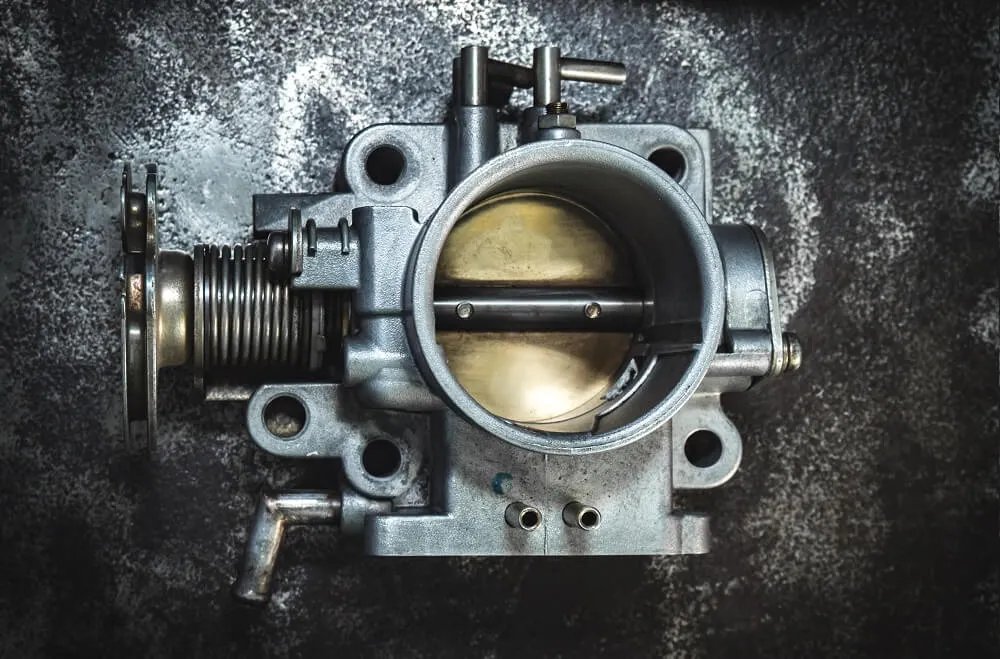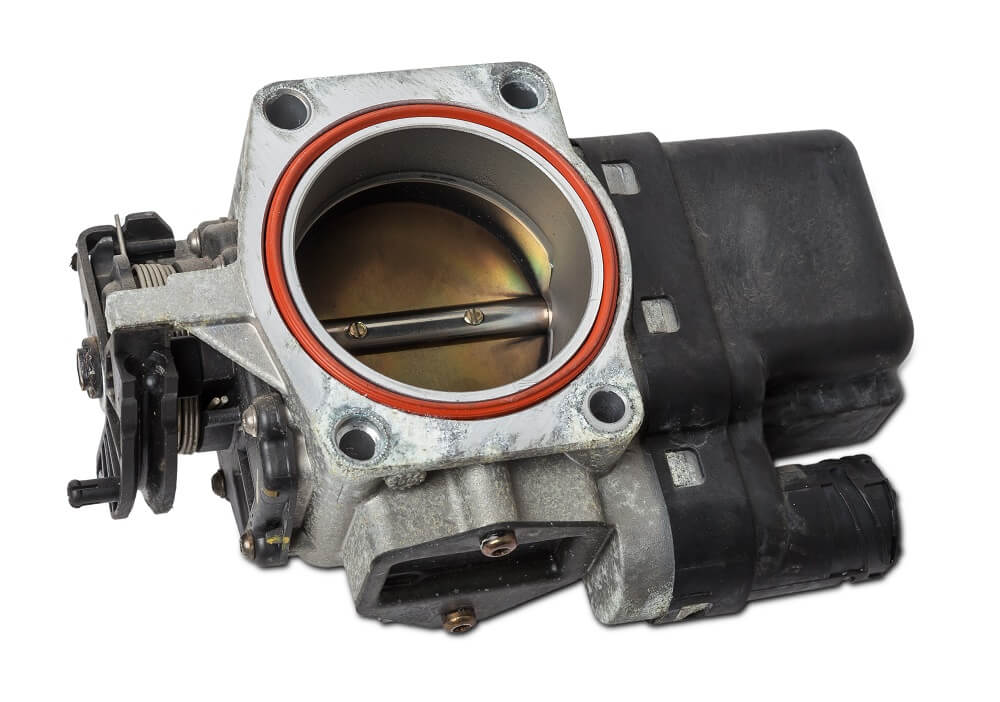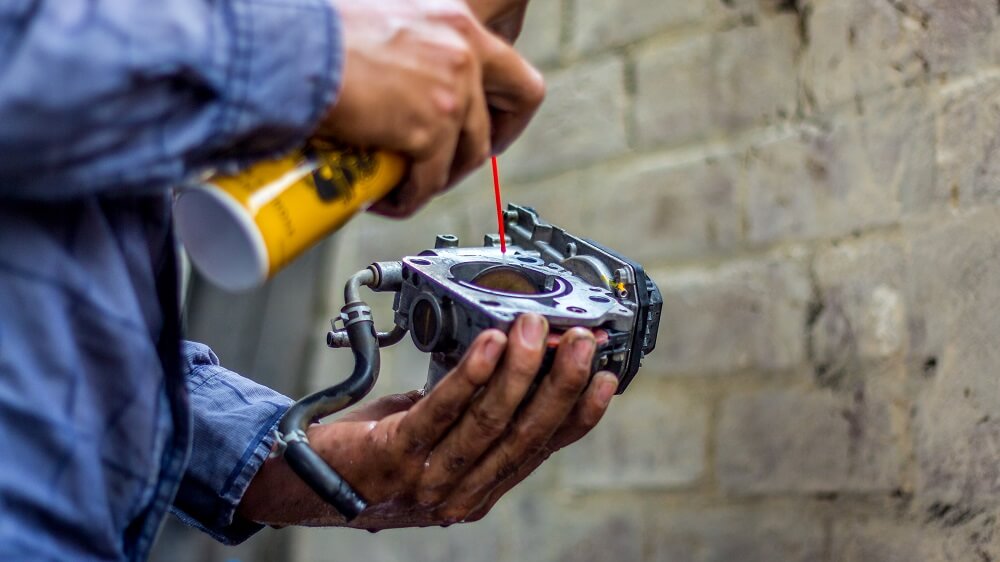What is a Throttle Body? What does a Throttle Body do?

WHAT IS A THROTTLE BODY, AND HOW DOES IT WORK?
There’s a lot that goes on under the hood of a car, and a lot of it is often taken for granted. Multiple components serve important purposes in getting the vehicle moving. These components also work harmoniously, just like the organs that make up our bodies. One of many such parts in a vehicle is a throttle body.
Its name is quite indicative of it having to do something with the throttle. The throttle is what you control with your right foot by pressing the accelerator or the gas pedal. The throttle body, meanwhile, is the part that feeds the engine with exactly the right amount of air, based on the input you provide via the gas pedal. While its purpose may not seem that complex, it’s a fairly complicated unit. Read on to know what it does and how it works.

WHAT IS A THROTTLE BODY?
A throttle body is one of the most important parts of the air intake system and its main duty is to control the air flowing into the engine. It works by acting as a valve restricting the amount of air that can enter the intake and is positioned between the air intake filter and the intake manifold. The restriction or permission of the airflow varies according to the input provided by the gas pedal.
The main component of a throttle body is the butterfly valve which is what physically dictates the amount of air you’re letting in. The more you push the accelerator pedal, the wider the butterfly valve opens. At wide-open throttle, the valve is completely open, letting the maximum amount of air inside the intake.
When more air gets into the combustion chamber or the engine, it will also be supplied with more fuel to maintain the correct air-fuel ratio. And when the amount of air and fuel going into the engine increase it begins generating more power while also running faster i.e. at higher revs.
A few decades ago, a carburetor was responsible for handling the task of a throttle body. A carburetor handled the amount of air going into the engine while also having other responsibilities. Its most important one was to mix air and fuel into a fine mist before supplying it to the combustion chamber. Whereas, that task is now handled by fuel injectors.
PARTS OF A THROTTLE BODY
Before we go any further, it’s important to get a rough idea of what makes your average throttle body. Since throttle bodies come in two main types – mechanical and electronic – we’ve listed the usual parts for each type.
Mechanical Throttle Body
- Butterfly valve
- Throttle position sensor
- Stop screw
- Idle air control valve
Electronic Throttle Body
- Throttle position sensor
- Flange
- Butterfly valve
- Throttle control valve
- Accelerator pedal position sensor
HOW DOES A THROTTLE BODY WORK?

As one would expect, the mechanical throttle body and the electronic one are slightly different when it comes to their inner workings. Here’s how each one works.
Mechanical Throttle Body
The biggest differentiating factor of the mechanical throttle body is that it uses a throttle cable to send input data from the accelerator pedal to the main throttle valve. This cable sits on a mechanism on the outside of the throttle body. Pushing down on the gas pedal leads to the cable getting pulled which in turn forces the valve open.
The throttle body also has a throttle position sensor which helps the vehicle’s ECU get an idea of how open the throttle is. Another sensor that works with the throttle body is the MAP sensor. While it’s not part of the throttle body, it’s mounted on it to gather data regarding the pressure behind the throttle plate. Pushing down on the gas pedal opens the butterfly valve which increases the airflow. And the pressure of the airflow is what the MAP sensor uses to help with the fueling process. A MAP sensor isn’t the same as a MAF sensor, which gets people confused at times.
If there’s increased pressure, the vehicle’s fueling system will send more fuel into the engine. Another component we mentioned earlier is the throttle body stop screw. This screw serves a simple purpose and that’s to define the upper limit of cable movement. It doesn’t need to be adjusted as it comes as it is already set to allow the valve to fully open.
The Idle air control valve, on the other hand, is what dictates the amount of air the engine gets while it’s at idle. It supplies the engine with essentially the minimum amount of air to keep it running smoothly. This valve also makes sure to supply the engine with additional air during cold starts for it to get to a running temperature quicker. There’s also an adjustment screw that’s part of the mechanical throttle body which can be used to increase or decrease the idle speed.
Electronic Throttle Body
An electronic throttle body is part of the electronic throttle control. The latter, as its name suggests, is responsible for controlling the throttle operation electronically. If a vehicle is equipped with this system it uses a drive-by-wire accelerator pedal, meaning that there’s no mechanical connection between it and the butterfly valve inside the throttle body.
The electronic throttle body is just like a mechanical unit in its work, but it makes use of an electric motor to control the butterfly valve. The ECM is what gathers information from all the sensors and passes the information to the electric motor. One of the most important sensors is the accelerator pedal position sensor. That being said, the ECM also is fed information from the engine speed sensor and the vehicle speed sensor.
ADVANTAGES OF AN ELECTRONIC THROTTLE BODY
Most vehicles today use electronic throttle bodies because they have a few advantages. However, many of these advantages aren’t clear from the driver’s seat. Interestingly, this lack of difference in terms of driving feel has been calibrated intentionally. These systems are designed to come as a smooth and seamless replacement.
As far as advantages, the multiple sensors and the precise workings help deliver better efficiency. The electronic throttle body is part of the electronic throttle control which measures and takes into consideration data like engine temperature, altitude, and a lot more. Thanks to the increased level of control, the throttle response has also become more responsive. This is evident under sudden acceleration and deceleration.
That’s not all, thanks to the electronic throttle bodies being more affordable, we are seeing an increase in features included in standard equipment. For instance, this technology makes introducing features like cruise control, traction control, and other safety systems quite easy. Another significant advantage comes in the form of more precise control over aspects like exhaust emission and air-fuel ratio control. Thanks to this, vehicles have also become much more fuel-efficient in recent years.
HOW DOES A LARGER THROTTLE BODY WORK?
Simply put, a larger throttle body works by increasing the size of the butterfly valve and reducing the restriction. That being said, it’s not as simple as that. While a larger throttle body does work, it won’t help much on a stock engine. As the factory throttle body is already large enough and won’t cause any restrictions. It also won’t increase the power for the same reason.
However, things get a little different if you have a modified engine. When an engine is modified to make more power, it requires more air and fuel that the stock throttle body can’t supply. This is where a larger or aftermarket throttle body comes in as they allow for an increased amount of airflow.
A larger throttle body works just like a regular-sized one other than the fact that it lets more air pass through it which will help the modified engine make more power and torque.
WHAT IS AN INDIVIDUAL THROTTLE BODY?

While we are on the subject of aftermarket throttle bodies and modified engines, it’s important to touch upon individual throttle bodies or ITBs. In the case of an ITB setup, each cylinder gets its own valve. What this means is that the cylinders aren’t required to share a single valve where the air is slow to reach each cylinder. When you push the gas pedal on a vehicle equipped with ITBs, air enters each cylinder almost instantly.
Another benefit to running individual throttle bodies is that they eliminate the requirement for an intake manifold. This is useful in racing applications. When it comes to use on the road though, vehicles with individual throttle bodies use intake manifolds to help get a supply of clean air. While it might seem like individual throttle bodies should be the way to go, they really aren’t the best option for average commuter cars as they can be quite expensive.
DOES A THROTTLE BODY NEED TO BE CLEANED?
Given the location and workings of a throttle body, it shouldn’t come as a surprise that it requires cleaning from time to time. The throttle body is positioned right after the air intake and all the air going to the engine passes through it. Yes, the air filter located in the air intake does capture most of the dirt before it makes its way into the throttle body and further into the engine. However, it doesn’t clean the air completely.
Tiny particles of dirt get through the air filter and end up on the inside of the throttle body. This collection of dirt also known as gunk forms around the valve and the area surrounding it. Consequently, the performance of the throttle body is affected, and it makes itself evident. If there’s a build-up of dirt in the throttle body, one will notice a sticky throttle or acceleration that just isn’t as smooth as it should be.
HOW TO CLEAN A THROTTLE BODY?

Cleaning a throttle body is simple. Most times, all that’s required to clean it is a dedicated solvent spray. If the dirt build-up is persistent, one can use a brush along with the spray. This method will almost always solve an issue related to a dirty throttle body.
The symptoms we mentioned above are also common to other problems, like a failing mass airflow or throttle position sensor. Those problems are a little more complicated to deal with as they require you to replace the sensors. Regardless though, it’s always a good idea to give the throttle body a clean if you notice jerky acceleration. It’s also the go-to fix for most mechanics.
While this can occur on modern vehicles with electronic throttle bodies, it’s slightly more common on older ones with mechanical units. Something else one needs to keep in mind with older vehicles is that the throttle body is controlled via a mechanical linkage. This involves a cable and a spring-loaded mechanism that allows the cable to operate the throttle body. These components don’t last forever and an issue with either of the aforementioned components could also lead to a similar problem.
Making sure your throttle body is clean will at least help you rule it out and diagnose the problem quickly. Throttle body cleaning is fairly easy to carry out, and we’d recommend that you try and do it yourself. There are solvent sprays specially designed for this purpose. They are called throttle body cleaners and aren’t just easy to find but also quite cheap to buy.


Leave a comment